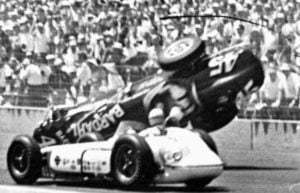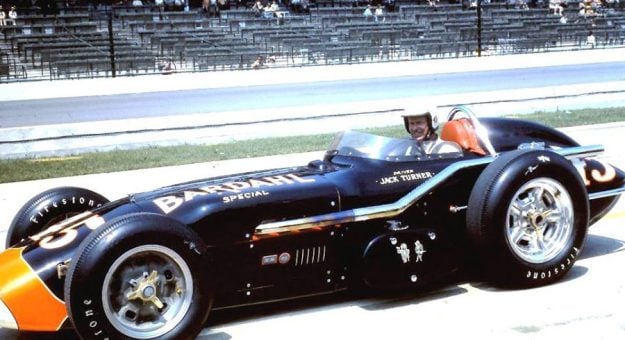Bandaged and splinted, his body monitored and supported by tubes and wires while confined to an Indianapolis Hospital in 1963, Jack Turner wryly remarked to an Indianapolis Times reporter, “Maybe it’s time to quit this job, looks like somebody is trying to tell me something.”
It was the third consecutive year that Turner had dramatically flipped and rolled down the frontstretch at Indianapolis Motor Speedway.
The first of his trio of stunning gyrations occurred on the 52nd lap of the 1961 500 while he was running in second place. Don Davis blew an engine and spun down the frontstretch. He climbed from his car and lazily sauntered across the track to the pits, while a half dozen drivers maneuvered wildly to avoid him.
Turner ran over a wheel and pirouetted high into the air.
In 1962, Turner repeated his 1961 main straight performance with a series of flips and rolls after getting caught up in a four-car melee 17 laps into the race. Unlike the year before when he escaped injury, Turner broke his pelvis in this flyer.
His third aerial tumble in a long, bulky 1960s-era roadster was the most devastating of his crashes. It took 11 weeks in the hospital and months of rehab for him to recover.

It happened while practicing on the second day of qualifying. Turner touched wheels with another car in turn four. His car skidded sideways and its tires grabbed the asphalt, sending it into a series of barrel rolls. The car tumbled somewhere between 13 and 15 times before grinding to a smoking, smoldering stop.
That was enough. Turner heeded that voice. He retired from his hospital bed, but his escapades lingered on to become a part of Indianapolis lore.
It’s a shame his legacy is defined by those accidents, for in fact, Turner was an accomplished race car driver.
Born in Seattle, Wash., in 1920, Turner possessed an early love affair with automobiles. While in high school, he worked at a local service station, where he spotted an ancient midget stuck in a corner, covered by a dusty tarp.
The 17-year-old pestered his boss until he sold it to him and let Turner rebuild it in the garage.
In 1938, he raced his creation for the first time at Jantzen Peach Bowl Speedway in Portland, Ore. The youngster quickly demonstrated enough promise to earn rides in better cars. He won regularly, but about the time his career was taking off, the outbreak of World War II ended all racing activities.
After spending three years in the heated combat of the South Pacific, Turner returned to the midget battles driving a new Kurtis/Offy purchased with hard-earned money he and his wife scraped together.
He gained the reputation of a “comer” and acquired the nickname “Cactus Jack,” bestowed on him by a track announcer who noticed the cowboy boots, the footwear from his riding stable day job, he wore while racing.
His success in the Northwest with the Kurtis encouraged Turner to travel to the Midwest in 1952 to chase midget races on the prestigious AAA circuit. That move proved rewarding, as he won the AAA National Midget Championship in 1954 and ’55, becoming the first driver to win consecutive titles.
During that era, however, success was often intertwined with disaster.
In 1954, Turner was involved in a tragic accident that haunted him for the remainder of his life. During a midget race at the Cincinnati Race Bowl, Johnny Key flipped and was tossed from his car.
Both Elmer George and Turner hit him. Key died as a result.
Turner was on the verge of quitting until his friend, Mike Nazaruk, insisted, “It wasn’t your fault, now get back in the damn car and drive.”
He did.
The success Turner achieved in the Midwest earned him a chance to test his ability at Indianapolis. Beginning in 1956, he ran six consecutive 500s before he stepped away from racing.
After he retired, Turner put his mechanical aptitude to work as an engineer with the Cummins Engine Co. And, despite the troublesome times he experienced at Indianapolis, he returned to the speedway annually until his passing on Sept. 12, 2004.
